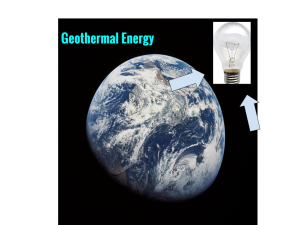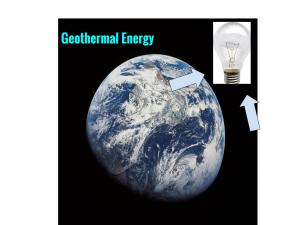Geothermal is a powerhouse that make wind energy
Geothermal energy can be used as an efficient heat source in small end-use applications such as greenhouses, but the consumers have to be located close to the source of heat.
Three different types of power plants – dry steam, flash, and binary – are used to generate electricity from geothermal energy, depending on temperature, depth, and
quality of the water and steam in the area.
In all cases the condensed steam and remaining geothermal fluid is injected back into the ground to pick up more heat. In some locations, the natural supply of water producing steam from the hot underground magma deposits has been exhausted and processed waste water is injected to replenish the supply.
Most geothermal fields have more fluid recharge than heat, so reinjection can cool the resource, unless it is carefully managed.
Production and Distribution
naturally occurring areas of hydrotherapy resources. They are deep underground and are largely undetectable above ground. Geothermal energy finds its way to the earth’s surface in three ways:
- Volcanoes and fumaroles (holes where volcanic gases are released
- Geysers Geothermal Reservoirs are
California generates the most electricity from geothermal energy.
The Geysers dry steam reservoir in northern California is the largest known dry steam field in the world and has been producing electricity since 1960.
Environmental Impact
The steam travels up pipes and spins turbines to make electricity. Another type pumps in the superheated water and spray it into tanks where it flashes into steam before it is released into the turbines.
Yet another kind of geothermal plant has a system of underground pipes that pass through very hot sections of rock.
Cold water is pumped into the pipes and steam comes out the other end.
This steam is used to generate electricity.
Geothermal is a powerhouse that make wind energy
Geothermal energy can be used as an efficient heat source in small end-use applications such as greenhouses, but the consumers have to be located close to the source of heat.
Three different types of power plants – dry steam, flash, and binary – are used to generate electricity from geothermal energy, depending on temperature, depth, and
quality of the water and steam in the area.
In all cases the condensed steam and remaining geothermal fluid is injected back into the ground to pick up more heat. In some locations, the natural supply of water producing steam from the hot underground magma deposits has been exhausted and processed waste water is injected to replenish the supply.
Most geothermal fields have more fluid recharge than heat, so reinjection can cool the resource, unless it is carefully managed.
Production and Distribution
naturally occurring areas of hydrothermal resources. They are deep underground and are largely undetectable above ground. Geothermal energy finds its way to the earth’s surface in three ways:
- Volcanoes and fumaroles (holes where volcanic gases are released
- Geysers Geothermal Reservoirs are
California generates the most electricity from geothermal energy.
The Geysers dry steam reservoir in northern California is the largest known dry steam field in the world and has been producing electricity since 1960.
Environmental Impact
The steam travels up pipes and spins turbines to make electricity. Another type pumps in the superheated water and spray it into tanks where it flashes into steam before it is released into the turbines.
Yet another kind of geothermal plant has a system of underground pipes that pass through very hot sections of rock.
Cold water is pumped into the pipes and steam comes out the other end.
This steam is used to generate electricity.
Mantle surrounds the core and is about 1,800 miles thick. It is made up of magma and rock.
- The crust is the outermost layer of the earth. The crust forms the continents.
Geothermal energy is generated in the earth’s core.
Temperatures hotter than the sun’s surface are continuously produced inside the earth by the slow decay of radioactive particles, a process that happens in all rocks.
The earth has a number of different layers:
Cost and Material
- I’ll need metal , wheels
- Materials for car seats
- Metal railing
- Rubber for the wheels.
Geothermal is a powerhouse energy that you can use for school and homes provided from wind energy is energy that moves wind turbines that makes energy by wind energy that makes energy to power homes with electricity.
 Mantle surrounds the core and is about 1,800 miles thick. It is made up of magma and rock.
Mantle surrounds the core and is about 1,800 miles thick. It is made up of magma and rock.
- The crust is the outermost layer of the earth. The crust forms the continents.
Geothermal energy is generated in the earth’s core.
Temperatures hotter than the sun’s surface are continuously produced inside the earth by the slow decay of radioactive particles, a process that happens in all rocks.
The earth has a number of different layers:
Cost and Material
- I’ll need metal , wheels
- Materials for car seats
- Metal railing
- Rubber for the wheels.
Geothermal is a powerhouse energy that you can use for school and homes provided from wind energy is energy that moves wind turbines that makes energy by wind energy that makes energy to power homes with electricity.

